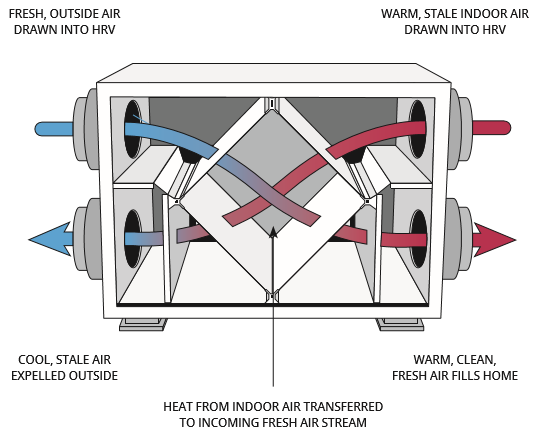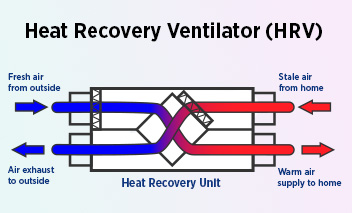Discovering the Conveniences of Heat Recovery Ventilation for Power Performance in Homes
Heat Recovery Ventilation (HRV) systems use homeowners a practical technique to improving power effectiveness. By recovering warmth from outbound air, these systems can significantly decrease cooling and heating prices. Additionally, they give a stable supply of fresh air, boosting indoor air quality and convenience levels. As house owners consider sustainable options, recognizing the subtleties of HRV systems comes to be significantly essential. What elements should one evaluate before making such a financial investment?
Recognizing Heat Recovery Ventilation Solutions

Just How HRV Boosts Indoor Air Top Quality

Energy Financial Savings: The Monetary Benefits of HRV
Optimizing power efficiency, heat recovery ventilation (HRV) systems supply significant financial advantages for house owners. By recuperating and reusing warmth from exhaust air, HRVs substantially decrease heating & cooling expenses. This innovation can bring about energy savings of as much as 30%, relying on environment and usage patterns. House owners typically observe lowered utility bills quickly after installation, making HRVs a monetarily smart investment over time. Additionally, numerous areas offer incentives or refunds for energy-efficient upgrades, better enhancing the monetary charm. As energy prices remain to climb, the cost-effectiveness of HRVs becomes progressively clear. Overall, the incorporation of HRV systems not just promotes power effectiveness yet also contributes to long-term economic cost savings for homes.
The Ecological Effect of Heat Recovery Ventilation
A substantial environmental benefit of heat recovery ventilation (HRV) systems hinges on their ability to lower general power usage. By reclaiming heat from exhaust air and moving it to inbound fresh air, HRV systems minimize the requirement for energy-intensive heating and cooling approaches. This decrease in power demand adds to decrease greenhouse gas emissions, as much less nonrenewable fuel source is needed to maintain comfy indoor temperatures. In addition, HRV systems improve indoor air top quality by efficiently trading stagnant air with fresh exterior air, reducing reliance on mechanical cooling systems that can hurt the environment. In general, the application of HRV systems sustains lasting living methods and lines up with worldwide initiatives to combat environment modification by advertising energy performance in domestic setups.
Choosing the Right HRV System for Your Home
How can home owners guarantee they select the right heat recovery ventilation (HRV) system for their needs? Initially, they should analyze their home's dimension and design, as these factors influence air flow requirements. Next, examining the system's efficiency rankings is crucial, as higher scores indicate much better my response performance and energy savings. House owners should also think about installment and maintenance costs, contrasting various brand names and designs for worth. Additionally, it's crucial to review noise levels, as some systems operate more quietly than others. Consulting with a/c professionals can supply tailored suggestions based upon particular home conditions. Lastly, taking a look at individual reviews and warranties can help in making an informed decision, guaranteeing that the selected HRV system efficiently boosts indoor air quality and energy effectiveness.
Frequently Asked Concerns

Just how Usually Should I Clean or Preserve My HRV System?
The frequency of cleansing or maintaining a warmth recuperation ventilation (HRV) system normally depends on use and ecological elements. Typically, it is advisable to execute maintenance every six months to assure peak performance and air top quality.

Can HRV Systems Help In Reducing Humidity Degrees Inside Your Home?
HRV systems can properly lower interior moisture levels by trading stale, humid air with fresh, drier air from outdoors. HRV Heat Recovery Ventilation. This process assists keep a well balanced interior setting, boosting convenience and protecting against moisture-related read this concerns
What Is the Lifespan of a Regular HRV System?
The life-span of a normal heat recovery ventilation (HRV) system varies, generally lasting in between 10 to 15 years. Routine maintenance can expand its efficiency and functional life, making certain peak performance throughout its usage look at here now duration.
Exist Any Sound Interest In HRV Systems?
Noise interest in HRV systems can develop, especially from follower operation. Several modern units are developed to decrease audio degrees, guaranteeing they operate silently while preserving efficiency, which resolves potential disruptions in living environments.
Can I Mount an HRV System Myself, or Do I Need a Specialist?
The private contemplated whether to install the heat recovery ventilation (HRV) system directly or work with a professional. Normally, while DIY installment is possible, expertise guarantees correct performance and conformity with local structure codes, enhancing system performance.